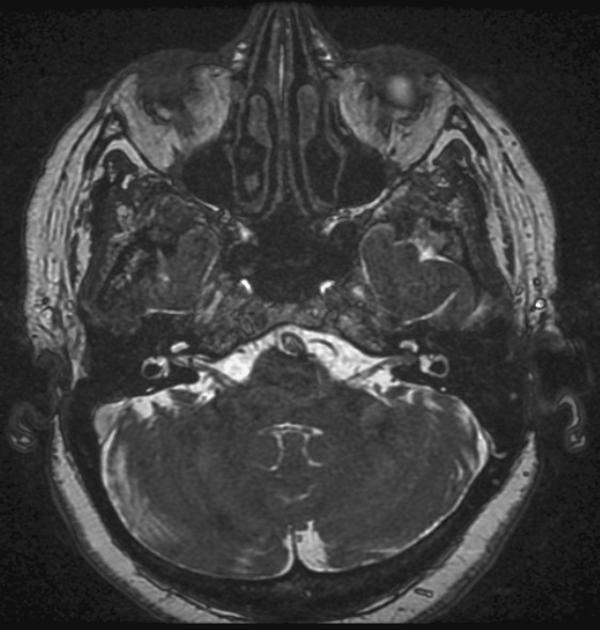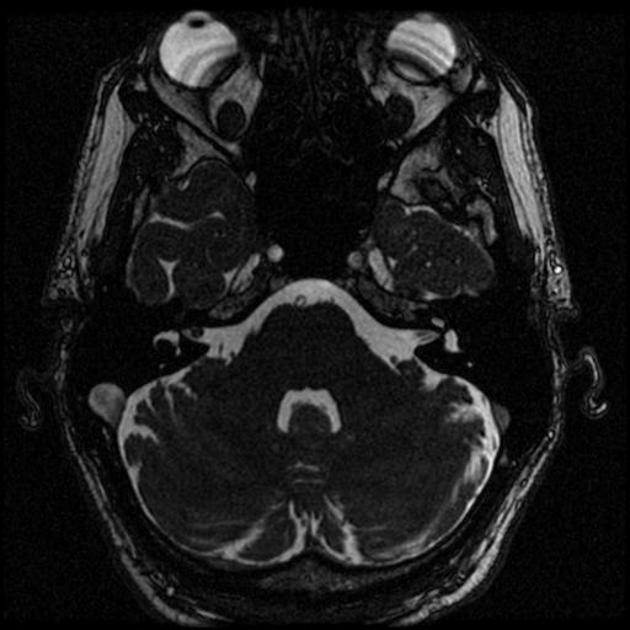Acoustic neuroma diagnostic study of choice: Difference between revisions
No edit summary |
|||
| Line 1: | Line 1: | ||
__NOTOC__ | __NOTOC__ | ||
{{Acoustic neuroma}} | {{Acoustic neuroma}} | ||
{{CMG}}; {{AE}} | {{CMG}}; {{AE}}{{M.B}} | ||
== Overview == | == Overview == | ||
[[Gadolinium]]-enhanced [[MRI]] scan is definitive diagnostic test of acoutic neuroma and can identify [[tumors]] as small as 1-2 millimeter in diameter. On brain MRI, acoustic neuroma characterized by hypointense mass on T1-weighted MRI, and hyperintense mass on T2-weighted MRI. | [[Gadolinium]]-enhanced [[MRI]] scan is definitive diagnostic test of acoutic neuroma and can identify [[tumors]] as small as 1-2 millimeter in diameter. On brain MRI, acoustic neuroma characterized by hypointense mass on T1-weighted MRI, and hyperintense mass on T2-weighted MRI. | ||
Revision as of 03:12, 18 January 2019
|
Acoustic neuroma Microchapters | |
|
Diagnosis | |
|---|---|
|
Treatment | |
|
Case Studies | |
|
Acoustic neuroma diagnostic study of choice On the Web | |
|
American Roentgen Ray Society Images of Acoustic neuroma diagnostic study of choice | |
|
Risk calculators and risk factors for Acoustic neuroma diagnostic study of choice | |
Editor-In-Chief: C. Michael Gibson, M.S., M.D. [1]; Associate Editor(s)-in-Chief: Mohsen Basiri M.D.
Overview
Gadolinium-enhanced MRI scan is definitive diagnostic test of acoutic neuroma and can identify tumors as small as 1-2 millimeter in diameter. On brain MRI, acoustic neuroma characterized by hypointense mass on T1-weighted MRI, and hyperintense mass on T2-weighted MRI.
Diagnostic Study of Choice
- Gadolinium-enhanced magnetic resonance imaging (MRI) is the preferred diagnostic test for identifying acoustic neuromas and can identify tumors as small as 1-2 millimeter in diameter.[1][2]
- Most acoustic neuroma have an internal acoustic meatus and often result in widening of the medial opening of the internal acoustic canal.
- Usually there is a small CSF cap between intracanalicular portion and the cochlea; occasionally, these tumors grow laterally through the cochlea (transmodiolar) or vestibule (transmacular) into the middle ear. Rarely they are small and confined to the vestibule (intravestibular) or to the cochlea (intracochlear) or both (vestibulocochlear).
- Extracanalicular extension into cerebellopontine angle (path of least resistance) can lead to "ice-cream-cone" appearance. Small tumors tend to be solid whereas cystic degeneration seen commonly in larger tumors. Haemorrhagic areas may also be seen. Calcification is typically not present.
| MRI component | Features |
|---|---|
|
|
|
|
|
|
Post-op MRI: Linear enhancement may not indicate tumor, but if there is nodular enhancement suspect tumor recurrence (needs follow up MRI).[3]


References
- ↑ E. P. Lin & B. T. Crane (2017). "The Management and Imaging of Vestibular Schwannomas". AJNR. American journal of neuroradiology. 38 (11): 2034–2043. doi:10.3174/ajnr.A5213. PMID 28546250. Unknown parameter
|month=ignored (help) - ↑ D. F. Wilson, R. S. Hodgson, M. F. Gustafson, S. Hogue & L. Mills (1992). "The sensitivity of auditory brainstem response testing in small acoustic neuromas". The Laryngoscope. 102 (9): 961–964. doi:10.1288/00005537-199209000-00001. PMID 1518359. Unknown parameter
|month=ignored (help) - ↑ Acoustic Schwannoma. Radiopedia(2015) http://radiopaedia.org/articles/acoustic-schwannoma Accessed on October 2 2015
- ↑ Image courtesy of Dr Frank Gaillard. Radiopaedia (original file here).[http://radiopaedia.org/licence Creative Commons BY-SA-NC
- ↑ Image courtesy of Dr. Roberto Schubert Radiopaedia (original file here).[http://radiopaedia.org/licence Creative Commons BY-SA-NC